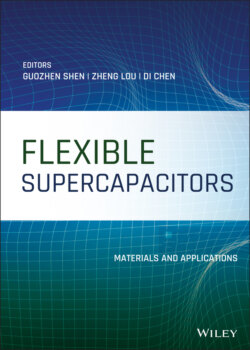Читать книгу Flexible Supercapacitors - Группа авторов - Страница 33
2.2.2.1 Fabrication of the Stretchable Planar SCs with Sandwich Structure
ОглавлениеSandwiched planar SCs is the most developed and widely applied structure in the field of the SCs. The main issues that impede the successful fabrication of stretchable SCs is how to make a tight connection between electrode materials and elastic substrate. As early as 2009, Yu et al. proposed a strategy via directly transferring the single‐walled carbon nanotube (SWCNT) film to pre‐strained PDMS substrate [64]. It's worth mentioning that the PDMS substrate was treated by UV light to forming a strong bong with SWCNT film. The fabrication process was presented in Figure 2.6a. Figure 2.6b showed the SEM images of the SWCNT film with buckled microstructures, which directly contribute to the stretchability of the fabricated SCs. Figure 2.6c displayed the CV profiles of the stretchable SCs measured at 30% strain. From the CV curves, we can see that the electrochemical performance of the stretchable SCs remains unchanged even under 30% applied tensile strain. But the utilization of a polymeric separator restricted its stretchability. To overcome this problem, Niu et al. reported stretchable SCs based on periodically sinusoidal oriented SWNT film without separator and liquid electrolyte using the same pre‐strained‐buckled‐release method, which showed increased stretchability of over 120%.
Most of the deformable substrate used in the field of stretchable SCs is PDMS. In 2014, Xie et al. reported a flat Ni foam based stretchable all‐solid‐state SC with wavy shaped polyaniline (PANI)/graphene electrode [65]. Figure 2.6d showed the schematics of the fabrication process for fabricating the PANI/graphene electrodes based stretchable SCs. First, a flat Ni foam with a thickness of 200 mm was manually made into a wavy shape, next, the porous graphene was synthesized on the buckled Ni foam via atmospheric pressure chemical vapor deposition (CVD). Then the graphene coated Ni foam was put in a solution of 3 M HCl to etch nickel foam to obtain wavy‐shaped graphene film. In order to improve the electrochemical performance of the SCs, the PANI was deposited on the wavy shaped graphene film. Finally, two PANI covered graphene films with PVA/H3PO4 wall were encapsulated into Elastic substrate (Ecoflex). Figure 2.6e depicted the CV curves of the stretchable SCs at different tensile strains. The initial specific capacitances calculated from CV curves were 261 F g−1. It can be seen that no obvious change appeared when the SC was stretched to 30%. Moreover, the stretching cycle tests revealed that the SC maintained high mechanical strength and stability over 100 cycles.
